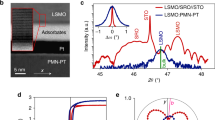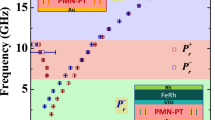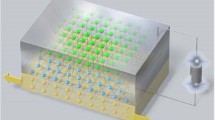Abstract
Magnetoelectric coupling1,2 between magnetic and electrical properties presents valuable degrees of freedom for applications. The two most promising scenarios are magnetic-field sensors3 that could replace low-temperature superconducting quantum interference devices, and electric-write magnetic-read memory devices that combine the best2 of ferroelectric and magnetic random-access memory. The former scenario requires magnetically induced continuous and reversible changes in electrical polarization. These are commonly observed, but the coupling constants thus obtained are invalid for data-storage applications, where the more difficult to achieve4,5 and rarely studied magnetic response to an electric field is required. Here, we demonstrate electrically induced giant, sharp and persistent magnetic changes (up to 2.3×10−7 s m−1) at a single epitaxial interface in ferromagnetic 40 nm La0.67Sr0.33MnO3 films on 0.5 mm ferroelectric BaTiO3 substrates. X-ray diffraction confirms strain coupling via ferroelastic non-180∘ BaTiO3 domains. Our findings are valid over a wide range of temperatures including room temperature, and should inspire further study with single epitaxial interfaces.
This is a preview of subscription content, access via your institution
Access options
Subscribe to this journal
Receive 12 print issues and online access
$259.00 per year
only $21.58 per issue
Buy this article
- Purchase on Springer Link
- Instant access to full article PDF
Prices may be subject to local taxes which are calculated during checkout




Similar content being viewed by others
References
Fiebig, M. Revival of the magnetoelectric effect. J. Phys. D 38, R123–R152 (2005).
Eerenstein, W., Mathur, N. D. & Scott, J. F. Multiferroic and magnetoelectric materials. Nature 442, 759–765 (2006).
Dong, S., Li, J. F. & Viehland, D. Ultrahigh magnetic field sensitivity in laminates of Terfenol-D and Pb(Mg1/3Nb2/3)O3–PbTiO3 crystals. Appl. Phys. Lett. 83, 2265–2267 (2003).
Astrov, D. N. The magnetoelectric effect in antiferromagnetics. Zh. Eksp. Teor. Fiz. 38, 984–985Sov. Phys. JETP 11, 708–709 (1960).
Folen, V. J., Rado, G. T. & Stalder, E. W. Anisotropy of the magnetoelectric effect in Cr2O3 . Phys. Rev. Lett. 6, 607–608 (1961).
Ryu, J., Vásquez Carazo, A., Uchino, K. & Kim, H.-E. Magnetoelectric properties in piezoelectric and magnetostrictive laminate composites. Jpn. J. Appl. Phys. 40, 4948–4951 (2001).
Hou, S. L. & Bloembergen, N. Paramagnetoelectric effects in NiSO4·6H2O. Phys. Rev. A 138, 1218–1226 (1965).
Schmid, H. Multi-ferroic magnetoelectrics. Ferroelectrics 162, 665–685 (1994).
Lee, M. K. et al. Strain modification of epitaxial perovskite oxide thin films using structural transitions of ferroelectric BaTiO3 substrate. Appl. Phys. Lett. 77, 3547–3549 (2000).
Brown, W. F. Jr, Hornreich, R. M. & Shtrikman, S. Upper bound on the magnetoelectric susceptibility. Phys. Rev. 168, 574–577 (1968).
Ascher, E., Rieder, H., Schmid, H. & Stössel, H. Some properties of ferromagnetoelectric nickel-iodine boracite, Ni3B7O13I. J. Appl. Phys. 37, 1404–1405 (1966).
Kimura, T. et al. Magnetic control of ferroelectric polarization. Nature 426, 55–58 (2003).
Hur, N. et al. Electric polarization reversal and memory in a multiferroic material induced by magnetic fields. Nature 429, 392–395 (2004).
Ponomarev, B. K. et al. Magnetoelectric properties of some rare earth molybdates. Ferroelectrics 161, 43–48 (1994).
van Suchtelen, J. Product properties: A new application of composite materials. Phil. Res. Rep. 27, 28–37 (1972).
Zavaliche, F. et al. Electric field-induced magnetization switching in epitaxial columnar nanostructures. Nano Lett. 5, 1793–1796 (2005).
Bratkovsky, A. M. & Levanyuk, A. P. Smearing of phase transition due to a surface effect or a bulk inhomogeneity in ferroelectric nanostructures. Phys. Rev. Lett. 94, 107601 (2005).
Dong, S., Zhai, J., Li, J. & Viehland, D. Near-ideal magnetoelectricity in high-permeability magnetostrictive/piezofiber laminates with a (2-1) connectivity. Appl. Phys. Lett. 89, 252904 (2006).
Kay, H. F. & Vousden, P. Symmetry changes in barium titanate at low temperatures. Phil. Mag. 40, 1019–1040 (1949).
Tsui, F., Smoak, M. C., Nath, T. K. & Eom, C. B. Strain-dependent magnetic phase diagram of epitaxial La0.67Sr0.33MnO3 thin films. Appl. Phys. Lett. 76, 2421–2423 (2000).
Urushibara, A. et al. Insulator-metal transition and giant magnetoresistance in La1−xSrxMnO3 . Phys. Rev. B 51, 14103–14109 (1995).
Mathur, N. D., Jo, M.-H., Evetts, J. E. & Blamire, M. G. Magnetic anisotropy of thin film La0.7Ca0.3MnO3 on untwinned paramagnetic NdGaO3 (001). J. Appl. Phys. 89, 3388–3392 (2001).
Wada, S. et al. Enhanced piezoelectric property of barium titanate single crystals with engineered domain configurations. Jpn. J. Appl. Phys. 38, 5505–5511 (1999).
Merz, W. J. The electrical and optical behaviour of BaTiO3 single domain crystals. Phys. Rev. 76, 1221–1225 (1949).
Krishnan, A., Treacy, M. M. J., Bisher, M. E., Chandra, P. & Littlewood, P. B. Efficient switching and domain interlocking observed in polyaxial ferroelectrics. Integr. Ferroelectr. 43, 31–49 (2002).
Shilo, D., Ravichandran, G. & Bhattacharya, K. Investigation of twin-wall structure at the nanometre scale using atomic force microscopy. Nature Mater. 3, 453–457 (2004).
Fousek, J. & Brezina, B. Relaxation of 90∘ domain walls of BaTiO3 and their equation of motion. J. Phys. Soc. Jpn 19, 830–838 (1964).
Ren, X. Large electric-field induced strain in ferroelectric crystals by point-defect-mediated reversible domain switching. Nature Mater. 3, 91–94 (2004).
Schröder, K. Stress operated random access, high-speed magnetic memory. J. Appl. Phys. 53, 2759–2761 (1982).
Burscu, E., Ravichandran, G. & Bhattacharya, K. Large strain electrostrictive actuation in barium titanate. Appl. Phys. Lett. 77, 1698–1700 (2000).
Thiele, C. et al. Influence of strain on the magnetization and magnetoelectric effect in La0.7A0.3MnO3/PMN-PT(001) (A=Sr,Ca). Phys. Rev. B 75, 054408 (2007).
Rhodes, R.G. Barium titanate twinning at low temperatures. Acta Crystallogr. 4, 105 (1951).
Acknowledgements
We thank M. Cain, G. Catalan, C.-B. Eom, I. C. Infante, E. C. Israel, F. D. Morrison and D. Viehland for useful discussions. W.E. is grateful to the EU for a Marie Curie Fellowship. Support from the UK EPSRC and The Royal Society is gratefully acknowledged.
Author information
Authors and Affiliations
Corresponding author
Ethics declarations
Competing interests
The authors declare no competing financial interests.
Supplementary information
Supplementary Information
Supplementary information, figures and table S1 (PDF 398 kb)
Rights and permissions
About this article
Cite this article
Eerenstein, W., Wiora, M., Prieto, J. et al. Giant sharp and persistent converse magnetoelectric effects in multiferroic epitaxial heterostructures. Nature Mater 6, 348–351 (2007). https://doi.org/10.1038/nmat1886
Received:
Accepted:
Published:
Issue Date:
DOI: https://doi.org/10.1038/nmat1886
This article is cited by
-
Room-temperature ferromagnetism and piezoelectricity in metal-free 2D semiconductor crystalline carbon nitride
Nano Research (2024)
-
Static and dynamic magnetization control of extrinsic multiferroics by the converse magneto-photostrictive effect
Communications Physics (2023)
-
Correlation between spin–phonon coupling and magneto-electric effects in CoFe2O4/PMN-PT nanocomposite: Raman spectroscopy and XMCD study
Journal of Materials Science: Materials in Electronics (2022)
-
Proton switching molecular magnetoelectricity
Nature Communications (2021)
-
Dielectric and impedance spectroscopy of (CoNiO3)0.5–(BaTiO3)0.5 solid solution for device applications
Journal of Materials Science: Materials in Electronics (2021)



